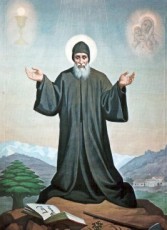Catholic Blesseds, Saints, Solemnities & Holy Days

Saint Sharbel Makhluf
Feast Day: July 24
Patronage: The Faithful
St. Sharbel Makhluf was born in 1828 in Bekaa Kafra in northern Lebanon. He was a Syriac-Maronite Monk and Priest, in the Eastern Church. His influence has spread widely although he never traveled far from his Lebanese Village.
St. Sharbel’s father died when he was three, and his uncle raised him. He joined the Monastery of St. Maron at Annaya, Lebanon when he was twenty-three. Although his name was Joseph Zaroun Makhluf, he chose the name of Sharbel in honor of a 2nd century martyr. He was ordained a Priest in 1859. People sought him out because of his reputation for holiness to seek his blessings or to be remembered in his prayers. He was adamant in following the example of a 5th century Saint, St. Maron. Because of this he lived as a hermit from 1875 until his death. He was very devoted to the Blessed Sacrament and followed a strict fast. Although when he was asked by his superiors to administer the Sacraments to the nearby village, he did so with joy.
He died on Christmas Eve in 1898 and not only Christians, but non-Christians made his tomb a place of pilgrimage and of cures. Pope Paul VI beatified him in 1965, and he was canonized in 1977. Pope John Paul II often said that, “the church has two lungs, the East and the West and it must learn to breath using both of them”.
St. Sharbel’s body is incorrupt to this day and can be seen. He joins a few of the Saints that make up the body of incorrupt saints today. His body shows no sign of any deterioration – 114 years later!
Practical Take Away
St. Sharbel helps the Church to appreciate both the unity and the diversity present in the Catholic Church. He was a Saint from the Eastern Church. He points to God and invites us to cooperate with the generous grace of God, no matter what our situation in life may be. He also teaches us that no matter how deep our faith is, as it becomes deeper and honest, we too, can become more ready to make a generous response to God. He is most known to the Eastern Church, which still honors him today by making pilgrimages to his tomb. By taking the advice of Blessed John Paul II, we have proof that the Church has two lungs – the Eastern Church, and the Western Church.





